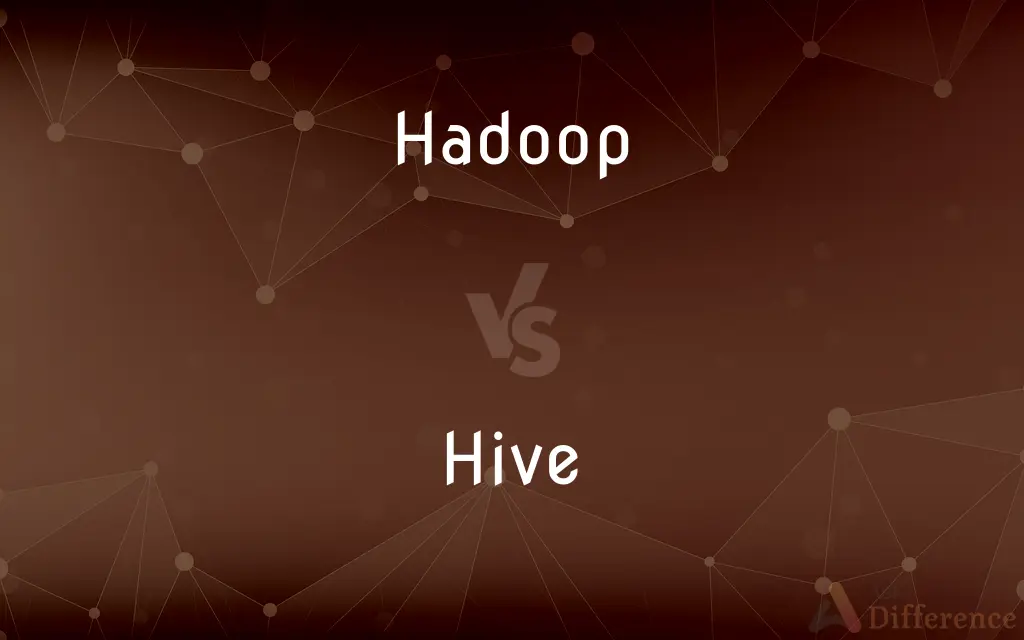Hadoop vs. Hive — What's the Difference?
By Tayyaba Rehman — Published on January 4, 2024
Hadoop is a distributed storage and processing framework for big data. Hive is a data warehousing tool that provides SQL-like querying for data stored in Hadoop.

Difference Between Hadoop and Hive
Table of Contents
ADVERTISEMENT
Key Differences
Hadoop is an open-source framework for storing and processing large datasets across clusters of computers. It uses a distributed file system (HDFS) and a processing engine (MapReduce) to handle big data workloads efficiently. Hadoop is designed to scale horizontally, making it suitable for handling massive amounts of data.
Hive is a data warehousing tool built on top of Hadoop. It provides a SQL-like language called HiveQL to query and analyze data stored in Hadoop's HDFS. Hive simplifies data processing tasks by offering a familiar querying interface, making it accessible to analysts and data scientists.
Hadoop is primarily used for storing and processing data, while Hive is used for querying and analyzing data. Hadoop deals with the infrastructure and distributed processing, while Hive focuses on providing a high-level querying language.
In Hadoop, developers write code in languages like Java for data processing tasks. Hive, on the other hand, uses HiveQL, a SQL-like language that is more user-friendly and doesn't require programming expertise.
Hadoop offers flexibility for custom data processing tasks but may require more coding. Hive sacrifices some flexibility for ease of use, making it accessible to a broader audience.
ADVERTISEMENT
Comparison Chart
Definition
Distributed storage and processing framework
Data warehousing tool for querying data in Hadoop
Usage
Storing and processing big data
Querying and analyzing data in Hadoop
Language
Java and other programming languages
HiveQL (SQL-like language)
User-Friendly
Requires coding and programming skills
Provides a user-friendly querying interface
Flexibility
Highly flexible for custom tasks
Sacrifices some flexibility for ease of use
Compare with Definitions
Hadoop
Hadoop scales horizontally.
Hadoop's distributed nature allows it to handle large workloads.
Hive
Hive is a data warehousing tool.
We use Hive for querying and analyzing data.
Hadoop
Hadoop is open-source.
We benefit from Hadoop's open-source community support.
Hive
Hive is built on Hadoop.
Hive leverages Hadoop's distributed storage.
Hadoop
Hadoop handles distributed computing.
We implement parallel processing using Hadoop.
Hive
Hive makes data accessible.
Analysts use Hive to explore data without coding.
Hadoop
Hadoop is a big data framework.
Our company uses Hadoop to store and process massive datasets.
Hive
Hive bridges SQL and Hadoop.
Hive allows SQL-like queries on big data stored in Hadoop.
Hadoop
Hadoop includes HDFS and MapReduce.
HDFS stores data, while MapReduce processes it in Hadoop.
Hive
Hive offers HiveQL.
HiveQL simplifies data querying tasks.
Common Curiosities
How does Hadoop work?
Hadoop uses a distributed file system (HDFS) and a processing engine (MapReduce) to store and process data across clusters of computers.
What is Hadoop used for?
Hadoop is used for distributed storage and processing of large datasets, especially in big data applications.
What is HiveQL?
HiveQL is a SQL-like language used in Hive to query and analyze data in Hadoop.
Is Hadoop a programming language?
No, Hadoop is a framework that can be programmed using languages like Java, but it is not a programming language itself.
What is Hive in Hadoop?
Hive is a data warehousing tool that provides SQL-like querying capabilities for data stored in Hadoop.
Do I need programming skills to use Hive?
No, Hive is designed to be user-friendly, and you can use it without extensive programming skills.
What are the advantages of using Hive?
Hive simplifies data querying and makes it accessible to non-programmers, and it provides a familiar SQL-like interface.
What are some alternatives to Hive for querying data in Hadoop?
Alternatives include Pig, Impala, and Spark SQL, each with its own querying language and features.
Can Hive replace Hadoop?
No, Hive is a tool that complements Hadoop. Hive is used for querying and analyzing data stored in Hadoop.
Is Hive part of Hadoop?
Hive is not part of the core Hadoop framework but is built on top of Hadoop, leveraging its capabilities.
Is Hive open-source?
Yes, Hive is an open-source project, and its source code is available for free.
Can Hive be used for real-time processing?
Hive is more suited for batch processing. For real-time processing, other tools like Spark may be more appropriate.
What companies use Hadoop and Hive?
Many large companies, including Facebook, Netflix, and Amazon, use Hadoop and Hive for big data processing and analytics.
What is the main difference between Hadoop and Hive?
Hadoop focuses on distributed storage and processing infrastructure, while Hive provides a user-friendly querying interface for data in Hadoop.
Can I use Hadoop without Hive, or vice versa?
Yes, you can use Hadoop without Hive for custom data processing, and you can use Hive with other data storage solutions, but they are often used together for big data applications.
Share Your Discovery

Previous Comparison
Ubuntu vs. Windows 10
Next Comparison
KVA vs. KWAuthor Spotlight
Written by
Tayyaba RehmanTayyaba Rehman is a distinguished writer, currently serving as a primary contributor to askdifference.com. As a researcher in semantics and etymology, Tayyaba's passion for the complexity of languages and their distinctions has found a perfect home on the platform. Tayyaba delves into the intricacies of language, distinguishing between commonly confused words and phrases, thereby providing clarity for readers worldwide.
















































